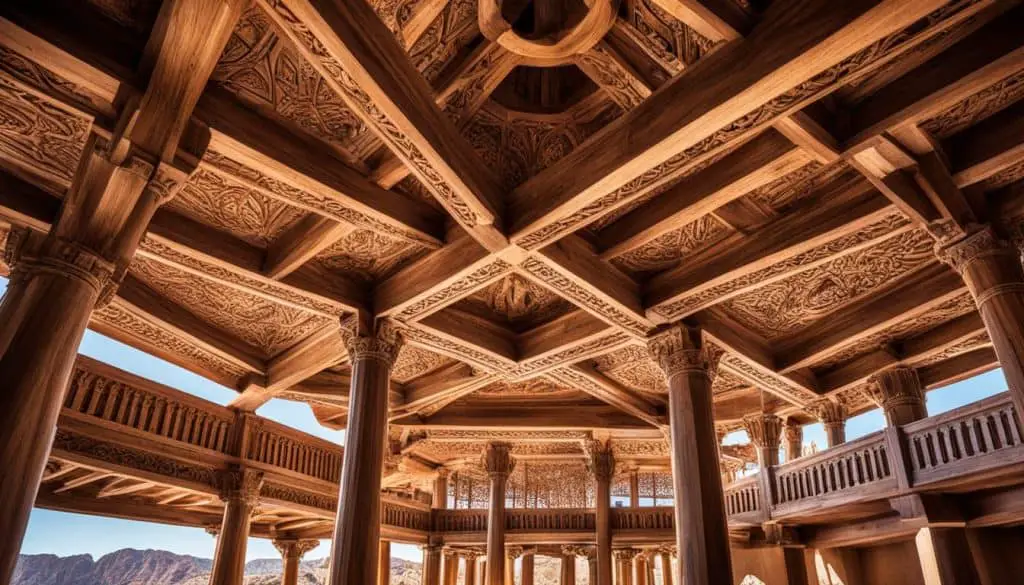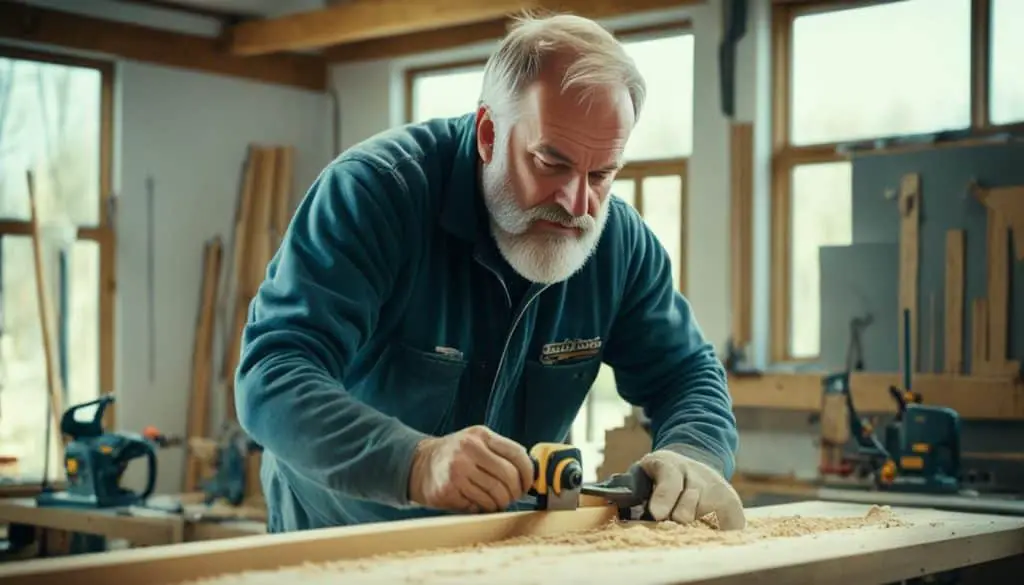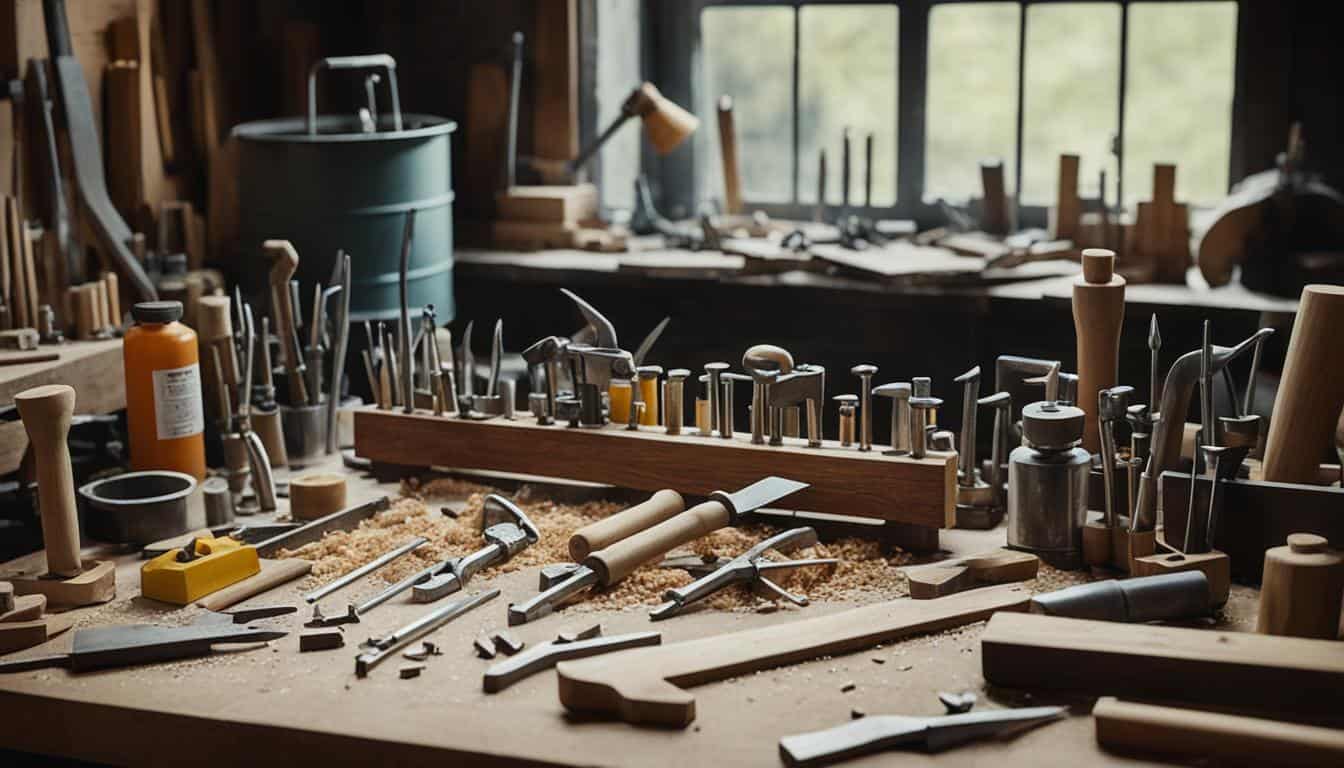Table of Contents
Did you know that carpenters were key in biblical stories? Joseph, a well-known figure, was a carpenter. Carpenters also helped build the Ark and create holy places. Their work connects deeply with religious tales. Let’s dive into how carpenters influenced stories of faith.
Joseph, who was Jesus’ foster father, was a carpenter. This is found in the Gospel of Matthew. Carpenters also played a big part in making the Ark and the Tabernacle. Plus, they helped King David with his dream of building a temple. They even worked on renewing holy areas during King Hezekiah’s time.
Joseph the Carpenter: The Foster Father of Jesus
Joseph was the husband of Mary and the foster father of Jesus. He’s known as the top carpenter in the Bible. Being called a “tekton” in Greek, Joseph’s skill with wood is highlighted in the Gospel of Matthew. This shows how important his work was.
His job as a carpenter shows not just his skill but also how humble he was. In those times, carpenters were highly respected. They made buildings and furniture for everyone’s use.
“A carpenter shapes wood with skill; He uses his hands to create something beautiful and functional for others.”
Joseph’s Carpentry Skills and Influence in Biblical History
Joseph’s work as a carpenter meant he could provide for his family. This included Jesus. He made things like furniture and tools for others too. His work helped create a stable life for his family and community.
Being a committed craftsman, Joseph’s story shows us the value of hard work. It also highlights how important it was to make useful things during that time.
Joseph: A Symbol of Faithfulness and Obedience
Joseph’s carpentry is more than a job; it’s a big sign in the Bible. He was chosen to be Jesus’ father on earth, showing huge faith and obedience. It’s a powerful message in the Bible.
His carpentry also helped build his personal qualities. The focus, accuracy, and patience in his work surely helped him in trusting God. This made him good at carrying out his important duties.
Building the Ark: Carpentry Skills of Noah
The tale of Noah and the Great Flood is a well-known one. It tells of Noah’s mission to save life on Earth by building an ark. Although it doesn’t say he was a carpenter, the ark’s complexity shows he likely had great carpentry skills.

“Building the Ark” highlights the massive task Noah undertook. Crafting the ark from gopherwood showed Noah’s advanced carpentry knowledge. He needed to know how to shape and join wood and make strong structures to build the ark.

Noah’s skill at following God’s word was clear in the ark’s quality. His carpentry skills made the vessel strong for the flood. They show how important craftsmanship is in God’s plans.
The Significance of Carpentry Skills
“By faith Noah, when warned about things not yet seen, in holy fear built an ark to save his family. By his faith he condemned the world and became heir of the righteousness that is in keeping with faith.” – Hebrews 11:7 (NIV)
For Noah, making the ark was about more than just building. It was an act of believing and obeying. His carpentry displayed his faith. It showed how closely human workmanship can be linked to God’s will.
This event highlights the importance of carpentry for God’s plans. Noah’s work was crucial in saving life. It kept God’s plan going for redemption.
The Tabernacle: Carpentry in Sacred Spaces
In the book of Exodus, we learn about the Mishkan or Tabernacle. It was where God lived among the Israelites in the desert. Skilled carpenters made this portable holy place. They followed detailed plans for its wooden parts, like frames and beams.
For the Israelites, the Tabernacle meant God was with them. It was built by talented carpenters. They made the complex wooden parts that supported this holy site.
“You shall make upright frames for the tabernacle of acacia wood.”
“Each frame shall be ten cubits long and a cubit and a half wide.”
“You shall make bars of acacia wood, five for the frames on one side of the tabernacle, and five bars for the frames on the other side of the tabernacle.”
The making of the Tabernacle focused on precision and skill. Carpenters crafted frames using acacia wood. They added bars to make it strong and stable.
It was a place where the Israelites met God. Carpenters’ hard work created an area for the divine connection.
The Tabernacle was later replaced by the Jerusalem Temple. Yet, its creation by skilled carpenters stands as a symbol of faith and craftsmanship. Their work is remembered in the making of future holy sites.

The Construction of the Tabernacle
Building the Tabernacle needed many craftsmen, not just carpenters. Metalworkers, weavers, and embroiderers all helped. Each had a key part in creating this sacred place.
It wasn’t only about wood. It included detailed tapestries, gold items, and more. By working together, these artisans turned the Tabernacle into a magnificent place of worship.
| Skilled Workers | Contribution |
|---|---|
| Carpenters | Crafted the wooden frames and beams |
| Metalworkers | Fashioned the sacred vessels and utensils |
| Weavers | Created the intricate tapestries and curtains |
| Embroiderers | Added intricate designs to the fabric |
The Tabernacle’s creation was a team effort, showing Israelites’ devotion. Skilled workers left a lasting mark on their worship. They set a high standard for sacred places to come.
King David and the Temple: Acknowledging the Need for Skilled Laborers
After he became king, David wanted to build a great temple. This temple would hold the sacred Ark of the Covenant. David knew he was better at fighting than building. He admits this in 1 Chronicles 28:3, saying, “But God told me, ‘You’re a warrior, so you won’t build my house.'” This shows the temple needed experts, like carpenters who had the right skills.

David’s decision not to build the temple was wise. He understood a big job like this needed experts in carpentry. To craft the temple’s detailed wooden structures, skilled carpenters were essential. Instead, David chose his son, Solomon, to realize his dream of the temple.
“You shall have skilled laborers of all kinds for the work of the LORD, craftsmen of every kind shall be at your disposal for the cutting of timber, so that the work may be carried out.” – 1 Chronicles 22:15
King David’s wisdom led him to bring together expert craftsmen. These carpenters were crucial for creating beautiful and strong parts of the temple. Because of them, the materials turned into marvelous works that showed the glory of God.
The Role of Carpentry in Temple Construction
Skilled carpenters were vital for the temple’s construction. They made the wooden parts that formed the temple’s basic structure. Tasks ranged from making beams and pillars to doors and furniture. Each work was a piece of art.
The temple’s construction demanded precise work and careful attention to detail. Every wooden component had to fit perfectly. This created a stable, beautiful space for worship. Carpenters prepared the wood for its sacred use, ensuring top quality.
They also worked with stonemasons and metalworkers. Together, they combined stone, wood, and metal in the temple’s design. By their skill in carpentry, these artisans helped make King David’s grand temple a reality.
The Significance of Skilled Laborers
David’s respect for skilled laborers, particularly carpenters, is an example of valuing expertise for divine tasks. He knew his own limitations and passed the building of the temple to those with the right skills. This choice honored God’s work.
This shows that high-quality work is important in God’s service. By choosing skilled laborers, David aimed to make a temple that perfectly showed God’s majesty. Therefore, the care in building reflected true worship.
| Name | Role |
|---|---|
| Skilled Carpenters | Designed and built the wooden framework, doors, and furniture for the temple. |
| Stonemasons | Worked together with carpenters to integrate stone and wood in the temple’s structure. |
| Metalworkers | Collaborated with carpenters to incorporate metal elements into the temple’s design. |
| Artisans | Combined their skills to create a harmonious and visually stunning sacred space. |
Repairing the Temple: Restoring Sacred Spaces
Centuries passed since the Tabernacle was first built. Under King Hezekiah, the temple faced a big problem. It had become rundown and needed a fresh start. King Hezekiah led a religious change and commanded the temple’s revival.
2 Kings 12:11 tells us skilled workers were brought in to help. Carpenters, in particular, were key. They used their skills to fix the temple’s wooden parts, like beams and frames.
The carpenters’ work shows how important it is to keep sacred places in good shape. By carefully fixing the temple, they showed their deep respect for their faith. The temple’s renewal was a mark of their dedication and spiritual beliefs.
King Hezekiah’s temple restoration is a tribute to the lasting value of skilled workers. Their hard work in keeping sacred areas intact is crucial. Their efforts help preserve old religious, cultural, and architectural treasures. These treasures still captivate and inspire us today.




